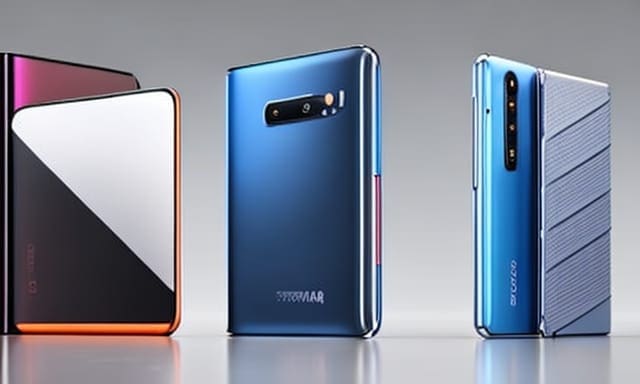The Evolution of Smartphone Design
The era of flip phones and sliders
Remember the days when flip phones and sliders were all the rage? These were the epitome of mobile technology just a decade or two ago. They offered a compact design and a satisfying snap when you closed them.
The rise of the touchscreen
Then came the touch screen, which changed the game entirely. The iPhone’s introduction in 2007 marked a new era, and soon after, the market was flooded with sleek, flat, touchscreen devices.
Modern trends in smartphone design
In recent years, we’ve seen bezel-less displays, waterdrop notches, and even pop-up cameras. But something new is on the horizon – foldable and rollable smartphones.
Introducing Foldable and Rollable Smartphones
Foldable smartphones
Foldable smartphones are like a modern twist on the classic flip phone. They feature a flexible display that can be folded in half, doubling the screen size while maintaining a compact form factor.
Rollable smartphones
On the other hand, rollable smartphones have a display that can be extended by rolling it out, giving you a larger screen when you need it and a smaller one when you don’t.
How they are revolutionizing form factors and design
Both foldable and rollable smartphones represent a significant shift in mobile design. They offer versatility, adaptability, and a more immersive user experience.
Challenges in Developing Foldable and Rollable Smartphones
Durability
One of the primary concerns with foldable and rollable smartphones is durability. Manufacturers must ensure these devices can withstand thousands of folds and rolls without damage.
Battery life
Battery life is another challenge. The larger, flexible displays require more power, and manufacturers must find ways to improve battery life without sacrificing performance or making the devices too bulky.
Display technology
Flexible display technology is still relatively new, and manufacturers must work on developing screens that are not only bendable but also resistant to scratches, cracks, and other potential issues.
The Future of Foldable and Rollable Smartphones
Innovative use cases
Foldable and rollable smartphones open possibilities for innovative use cases, such as gaming, multitasking, and content creation. Imagine playing a game on a large screen or having multiple apps open side by side, all on a device that fits in your pocket.
Potential impact on the industry
Introducing foldable and rollable smartphones could disrupt the mobile industry, forcing other manufacturers to adapt and innovate. It might even pave the way for entirely new categories of devices.
Environmental considerations
As technology advances, it’s essential to consider the environmental impact of these new devices. Manufacturers must strive for sustainable production processes and encourage the recycling and repurposing old devices.
The Impact on User Experience and Accessibility
Enhanced user experience
Foldable and rollable smartphones offer an enhanced user experience by providing larger screens, which can make consuming content, browsing the web, and using apps more enjoyable.
As these devices become more widespread, developers may create apps specifically designed for their unique form factors, further improving user experience.
Accessibility improvements
These new form factors can also bring accessibility improvements for users with disabilities or special needs. Foldable and rollable smartphones can be customized to adapt to individual needs, such as displaying larger text, providing alternative input methods, or offering unique interfaces that cater to specific disabilities.
Potential Applications in Various Industries
Healthcare
Foldable and rollable smartphones could play a vital role in the healthcare industry. Their larger screens can make it easier for medical professionals to view and analyze medical data, images, or patient records on the go. Additionally, their compact form makes them more portable, allowing doctors and nurses to carry them around easily during rounds.
Education
In education, foldable and rollable smartphones can serve as versatile learning tools. They can act as a compact smartphones for regular use and a tablet for educational purposes, providing a larger screen for studying, reading, or watching educational content.
Entertainment and Gaming
The entertainment and gaming industry could benefit significantly from the larger screens of foldable and rollable smartphones. Mobile gamers would enjoy an immersive gaming experience with more screen real estate.
At the same time, movie and video enthusiasts could watch their favorite content on larger displays without carrying a separate tablet.
Frequently Asked Questions (FAQ)
- Are foldable and rollable smartphones durable?
- While there have been some concerns about durability, manufacturers continually improve the design and materials to ensure these devices can withstand everyday use.
- Do foldable and rollable smartphones have a shorter battery life?
- Larger displays may require more power, but manufacturers are working on optimizing battery life to ensure a satisfactory user experience.
- Are foldable and rollable smartphones more expensive than traditional smartphones?
- Due to the new technology and materials, foldable and rollable smartphones may initially have a higher price point. However, as production scales up and technology advances, prices are expected to become more competitive.
- Will all smartphones eventually become foldable or rollable?
- It’s difficult to predict the future of mobile design, but foldable and rollable smartphones are likely to become more prevalent as the technology matures and user demand grows.








